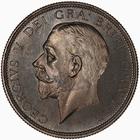The pre-decimal florin (2s) was a unit of currency equalling two shillings, or one tenth of a pound sterling, or twenty-four pence. There were six types of florin issued before this one: the so-called Godless Florin (1848 and 1849), followed by the Gothic Florin (1851 - 1887), the Jubilee Florin (1887 - 1892), a florin featuring three shields (1893 - 1901), the Britannia Florin (1902 - 1910) and the first florin issue of King George V (1911 - 1926).
In 1927, much of the coinage was re-designed by George Kruger Gray, including the florin. His design preserves the layout of a cruciform of shields bearing the Arms of England (repeated twice), Scotland and Ireland; however, the shields are not crowned; the reverse also displays part of the monarch's legend, continuing from the obverse. This coin type was only issued until 1936, and was then replaced by the King George VI two shillings in 1937.
The composition of the coins is 0.500 silver with 0.1818 oz ASW (ounce of Absolute Silver Weight). When the currency became decimal in 1971, by which point the denomination was already debased to copper-nickel, florins were re-denominated as ten new pence; they remained legal tender until 1993, when a smaller type of ten pence replaced them. |
| Reverse | |
|---|

Within a beaded border, the reverse design features a cruciform of four shields forming a cross around the King's initial, the letter G; the cross is diagonal (rotated 45 degrees). The shields bear the arms of England (above left and below right): three lions "passant guardant", Scotland (above right): a rampant lion, and Ireland (below left): a harp.
Dividing the shields are four sceptres ending with crosses, each surmounted by a representation of St. Edward's Crown.
Around above, divided by the upper crown, the continuation of the monarch's legend: FID · DEF IND · IMP (Defender of the Faith, Emperor of India). Around below, the date of issue [year] followed by the denomination · ONE FLORIN, divided by the lower crown.
The designer's initials KG are in small letters below, separated by the lower crown. |
|






